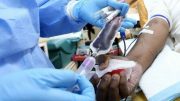The state of public health in the United States is at a critical juncture. ‘Can it recover?’ is now the question.
America’s public health system was the envy of the world before the outbreak.
The United States was placed first among 195 countries in late 2019 by the Globe Health Security Index in terms of being prepared to handle a public health disaster, far ahead of the second-best country, the United Kingdom.
That quickly changed. The United States was classified “worst globally” in terms of COVID-19 cases and deaths, according to research published by the National Center for Biotechnology Information less than a year later.
The Biden administration spent over $8 billion last year to shore up departments in an attempt to rebuild the nation’s chronically underfunded public health system.
Experts warn it will take a lot more than that to fix America’s public health system, two years to the day after the first verified case of COVID-19 in the United States.
Even before COVID-19, health departments were “running on empty,” according to former Baltimore health commissioner Dr. Leana Wen, who said that money was being diverted from previous priority priorities to cover current ones. “We were continually robbing Peter to pay Paul,” says the narrator.
Many departments are so short for cash that they don’t even have the tools to consider how to spend the new federal funds strategically, according to Wen.
Robert Kirkpatrick, who lives and works about an hour outside of Austin, Texas, hasn’t taken a genuine vacation in two years, and 70-hour workweeks aren’t uncommon.
Kirkpatrick, executive director of the Milam County Health Department, said, “After a while, I made it a point to try to take some time off at least one day a week.” “You must take a short break for your own mental health.”
Kirkpatrick’s 25 years of service in the Texas Army National Guard had prepared him well for the epidemic. However, it has been tougher than his tenure as a company commander in Iraq.
“I get to go home and see everything I’ve been missing out on because of the long hours at work,” he explained.
As the pandemic approaches its third year, public health agencies are inundated with similar tales of long hours, unpleasant work, and threats from the individuals they’re attempting to assist.
Hundreds of public health employees have left local or state government since the pandemic began, at a time when the country may need them more than ever. The county health director for the Orlando area was placed on administrative leave by Florida Gov. Ron DeSantis’ administration on Wednesday for pushing his staff to get vaccinated.
Although applications to certain public health institutions have increased by as much as 50%, replacing the skills lost would take years, according to Dr. Megan Ranney, an emergency department physician and academic dean at Brown University’s School of Public Health.
According to the Centers for Disease Control and Prevention, more than half of 26,000 states, local, and tribal public health professionals reported mental health difficulties such as depression, anxiety, or post-traumatic stress disorder in July 2021, and 8% claimed they had considered suicide.
COVID-19 has caused public health agencies in most states to overlook their other responsibilities.
Dr. Michael Kilkenny, executive director of the Cabell/Huntington Health Department in West Virginia, said, “We’ve lost progress in overdose mortality and HIV transmission.”
“We just undertook a rudimentary level of West Nile virus vector surveillance and control… Nobody was sent out to look for ticks “he stated, “We even had to bring someone out of retirement to teach food handler classes because our regular sanitarians were on call.”
The majority of people are unaware of public health systems until they fail, but everyone benefits from clean water and air, safe restaurants, infection control, and healthy babies—all of which are consistently supported by public health departments.
“No one ever praises you for not catching polio,” remarked Thomas LaVeist, dean of Tulane University’s School of Public Health and Tropical Medicine.
Dr. Umair Shah, Washington’s secretary of health, believes the pandemic has taught public health professionals a lot about how to fight a pandemic, but he is concerned that usual crisis-thinking would lead to those lessons being forgotten before the next pandemic strikes.
“COVID places public health at a fork in the road, where things may either be transactional or transformative,” he explained. “Shame on us if we don’t learn those lessons and alter our systems, including in terms of health disparities.”
Running on fumes
Dr. Mandy Cohen, who stepped down as secretary of the North Carolina Department of Health and Human Services in December, transferred workers from critical services like restaurant inspections and mental health care to deal with COVID-19’s requests nearly two years ago. Her department remained in a state of “crisis.”
Cohen said the most important thing she’s learned from the pandemic is how different it is from the typical emergencies the agency deals with, such as hurricanes. She claimed she could obtain support from surrounding states in prior situations, but now they’re all in the same boat.
“When everyone is hurting, there is no phone-a-friend,” she explained.
According to Dr. Jerome Adams, who served as surgeon general during the Trump administration, the pandemic highlighted long-standing health issues.
COVID-19 outcomes in the United States were poorer than in many other nations, according to Adams, an anesthesiologist and first executive director of health equality programs at Purdue University in Indiana. Obesity, diabetes, and smoking are all risk factors for COVID-19 severe instances, and obesity affects 43 percent of Americans.
Adams expressed concern about what would happen if the country fails to recognize the benefits of a strong public health system.
“We’re seeing a backlash against public health, with people becoming increasingly resistant to vaccination and prevention,” Adams said. “That makes me nervous.”
Adams wants to see more money committed to health communication, which has been a problem for both the Trump and Biden administrations, he added.
“In the same manner that Nabisco promotes Oreos, we need to market health messaging,” Adams added. “If we can get folks to drink Bud, purchase a Ford, or eat an Oreo, we should be able to help them understand why and what they should be doing to stay healthy.”
Even inside government, according to Pramod Dwivedi, health director of the Linn County Public Health Department in Cedar Rapids, Iowa, public health organizations are frequently the last to be told.
Dwivedi added, “We were always caught off a surprise.” “The state held press conferences that we were not informed about. All of these abrupt changes occur without prior notice to us. Then people start phoning us, and we have no way of defending our actions.”
A financial necessity
Dr. Jody Heymann, professor of health policy and management at UCLA’s Fielding School of Public Health and founding director of the WORLD Policy Analysis Center, believes that keeping people well is critical to a successful economy.
Prior to the epidemic, America spent more per capita on health care than any other country on the planet. “We have a per capita income that is more than 50% greater than the next on the list,” she remarked.
In the same period, the United States was ranked 40th in the world in terms of life expectancy by the World Health Organization. “All of the things that yield more life expectancy at a lower cost have been persistently underinvested in,” Heymann added.
According to Dr. Anand Parekh, chief medical adviser of the Bipartisan Policy Center in Washington, this underinvestment amounts to around $10 billion every year. He described any allowed spending as a “down payment.”
Dr. Walter Orenstein, a global health expert at Emory University in Atlanta, where he manages vaccine policy and research, says it’s simpler to market drugs than prevention.
“You receive therapy, you feel better, and you are aware of what has occurred. You’ll never become sick if I give you a vaccination, and you’ll never know how it transformed your life “he stated
He believes that a long-term investment in public health is necessary to address health emergencies.
“People don’t realize it costs money to invest in prevention,” he said. “It’s just not as costly as failing to invest in prevention.”
Many authorities told USA TODAY that money is typically granted to public health during a crisis and then taken away once the crisis is passed.
Arizona’s public health department received two years’ worth of money during the Ebola outbreak in 2014. Will Humble, the department’s director and executive director of the Arizona Public Health Association, remarked, “More than you could ever spend.”
The money then vanished. Officials are concerned that something similar will happen again.
The most pressing demand in public health is adequate manpower, yet departments can’t hire if their funds are limited.
“A lot of the county health officers here don’t want to create positions and then have to lay people off or go to their county board of supervisors and beg for permanent funding to keep them on,” Humble said.
According to Michael Fraser, CEO of the Association of State and Territorial Health Officials, staffing up isn’t a waste of money.
“Just because you have a public health infrastructure doesn’t imply you have a bunch of people sitting around doing nothing,” he explained. “What about well-baby visits and tracing STD contacts? There is a lot to do.”
Smaller counties, according to Humble, cannot add staff in the immediate term. “They’re completely freaked out. They simply cannot afford to spend this much money on the staff.”
Long-term sustainability of a program necessitates a constituency that keeps pushing, he noted. When there is a surplus of funds, public health officials will spend it on anything to get it off the books.
“Constituents are asking about COVID-19 right now, but they won’t in three years,” Humble added. “Then it’ll be, ‘People aren’t calling me about it anymore, so let’s get rid of it.'”
Is this a missed opportunity?
According to Carolyn Mullen, chief of government affairs and public relations at the Association of State and Territorial Health Officials, states and localities slashed the public health budget by 15% in 2018 and 2019.
“We were asked to build skyscrapers on top of a shaky base,” she explained.
According to a report released by the de Beaumont Foundation in October 2021, state and local public health departments will need to hire at least 80,000 more full-time equivalent positions—an increase of nearly 80%—just to get back to where the workforce was a decade ago in order to provide basic, everyday services.
Another issue is that disease reporting and funding systems are separate. Congress spends money on diseases like HIV, TB, and West Nile Virus, but not on pathogens in general.
“We built fantastic systems for COVID,” Fraser explained, “but we didn’t develop any capacity for the future.” “It may be expanded, but I’m not sure if the financing would enable it because it’s for COVID. That is the problem.”
“Long-term, sustainable, regular support that is not related to one specific disease is needed,” Mullen said, “so we can move away from this feast and famine.”
The failure of President Joe Biden’s Build Back Better infrastructure program, which included significant and long-term public health investment, was a tremendous setback, according to Fraser.
“This has always been the method for public health,” Fraser added. “It’s been two years, and many of these COVID payments are about to expire. We’re going to return to where we were, and this is something that happens all the time.”
Public health, like bridges and roads, should be considered public infrastructure, according to Parekh of the Bipartisan Policy Center.
He believes that focusing on why public health is vital to people’s daily lives—for clean air, water, and food—will help it move away from partisan politics. “Partnering with the communities we’re attempting to serve to guarantee that people are healthy and can reach their goals is when public health is most successful.”
According to Parekh, the Republican governor of Indiana established a bipartisan commission to improve public health. He believes both sides of the aisle should put in more effort “so that you don’t get the impression that public health is trying to tell you what to do. It has to be that public health is attempting to assist the general public in attaining its objectives and creating healthy communities and ecosystems.”
Building confidence, according to Parekh, will take time and effort, as well as people realizing that public health professionals are looking out for their best interests.
“Right now in our country’s history, there’s an opportunity to think differently about public health,” Parekh added. “The question is whether we will seize this opportunity now. When, if not now, will it be?”
A plan for the future
A group of corporate and civic leaders in Rhode Island assisted in the development of a plan to leverage federal public health financing to solve social issues. According to Neil Steinberg, president, and CEO of the Rhode Island Foundation, people can’t be healthy if they live in their cars or on the streets.
He replied, “Now we have some funding to make a dent.” “I’m optimistic that these dollars can be used to improve it if they’re used wisely, attentively, and projects are truly implemented.”
The emphasis is on long-term programs that will not expire in three years when financing is no longer available, according to Steinberg.
His group would have to wait to see if the state Legislature approves the recommendations, which could happen as soon as June, he added.
Barbara Ferrer, the director of the Los Angeles Department of Public Health, said she already knows how she’ll spend the new federal funds: invest in equity-focused programs and support networks.
Her department set up six stations across the county to deliver immunizations, and she claimed they won’t be leaving even when the pandemic is over.
According to Ferrer, having access to the community through these sites allowed the department to better connect with residents, understand their problems, and create trust.
The locations established programs to subsidize nutritious food, provide mental health treatments, avoid violence, and fight for stronger labor protections so that unwell workers can stay at home and isolate themselves.
These were all issues that needed to be addressed for a long time, according to Ferrer, but the establishment of the sites and the funding to keep them running will make a significant difference in Los Angeles’ public health.
The department budgeted $10 million for a supermarket voucher scheme and $2 million for healthy food subsidies. “You can’t urge people to eat well when they don’t have access to nutritious things,” she said. $13 million will be used to extend home visiting services for at-risk individuals, and $7.5 million will be used to expand community-based partnerships.
“I’m hopeful we’ve taken advantage of the reality that when a tragedy of this magnitude happens, there are possibilities to move forward and fundamentally fix it,” Ferrer added.
Kirkpatrick, who lives in Milam County, Texas, expects to get more harassment in the form of phone calls, emails, and even strangers on the street.
He remarked, “I take everything with a grain of salt.” “It’s because they’re terrified, I’m sure. They don’t know and are looking for answers. I’ll do my best to deliver those responses.”
The long hours, public outrage, and the heartbreak of losing community members are all part of the commitment public health officials make to their communities, according to Kirkpatrick.
“When you sign up for public service, whether it’s military, law enforcement, firefighting, working in a hospital, or working in public health, it becomes a part of you,” he said. “It’s what we’re good at.”
A grant from the Masimo Foundation for Ethics, Innovation, and Competition in Healthcare has helped USA TODAY cover health and patient safety. The Masimo Foundation does not contribute to the editorial process.






eva elfie new videos https://evaelfie.site/ eva elfie photo
eva elfie https://evaelfie.site/ eva elfie full video
You have noted very interesting points! ps nice
website.Expand blog